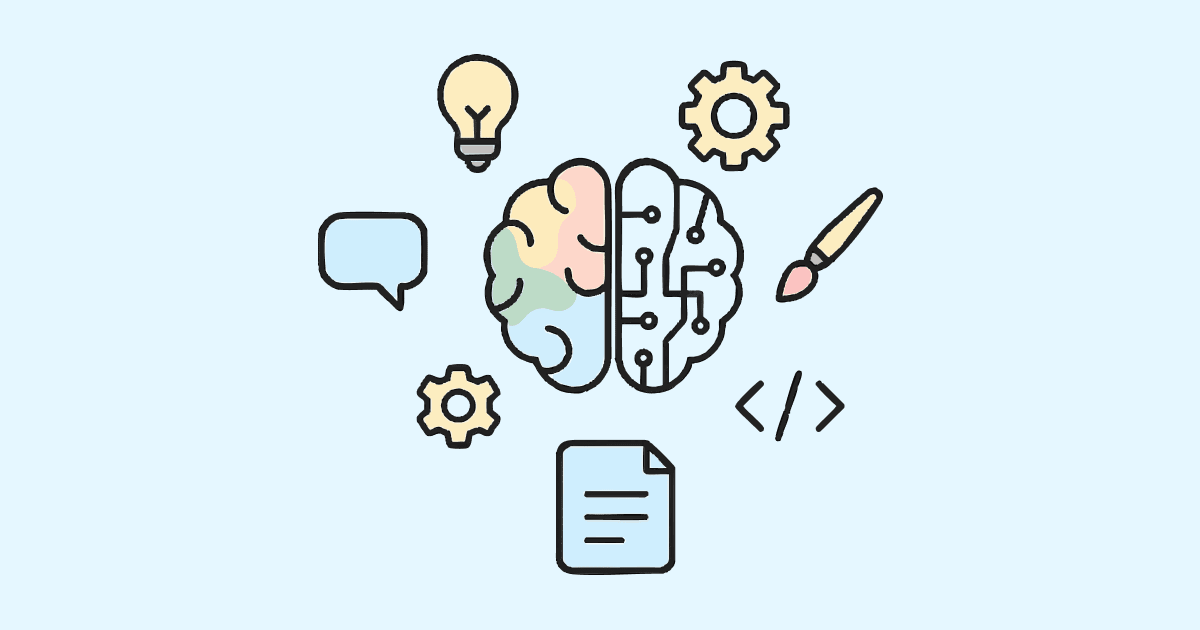AI, human skills, and the future of work: Exclusive insights from GoodHabitz research

AI and the future of work isn’t theory – our GoodHabitz research reveals how employees are really using AI today.
This exclusive research reveals some compelling takeaways around:
- The adoption of AI in the workplace
- The growing importance of human skills
- How organisations must adapt to the rising demand for new skills
These insights have also been further enriched by contributions from subject-matter experts.
Keep reading on further to discover the full story.
AI and the future of work: Insights from GoodHabitz research
We set out to better understand how AI will change the future of work; specifically, to get clarity on the state of human-AI collaboration.
‘In 5 years time, AI will do that job.’
‘AI will replace that role.’
‘Can’t we just automate that process? Do we really need people for this?’
These are just a handful of the sayings that are perhaps sounding all-too familiar to us.
But we believe that this ‘doom-and-gloom' mentality is a result of a misunderstanding, that we’re going to correct:
To foster innovation and long-term success, there is a need and an opportunity when AI and human intelligence are blended together.
Mark Bowden, Body Language Expert and Keynote Speaker, joined an episode of The Moving Forward podcast, and shared the following:
“As long as we have human beings on the planet, human beings will want to talk to other human beings. That’s never changed and never will change.”
“Furthermore, my understanding around AI at the moment, is that you still have to be able to talk to it and instruct it like it’s a human being.”
He shared his full take around the human advantage of leveraging AI in the podcast episode, that you can tune in and watch below.
Before we go any further, here’s some information about the study:
This research was commissioned by GoodHabitz and conducted by Censuswide. It surveyed a sample of 2,014 employed respondents in the UK. Data collection took place between 23rd and 29th August 2024. Censuswide adheres to the Market Research Society (MRS) Code of Conduct and ESOMAR principles, ensuring high standards in research methodology. Additionally, Censuswide is a member of the British Polling Council.
How is AI being used in the workplace?
The research revealed some interesting insights around AI usage in the workplace.
We found that most employees use generative AI technologies at work for a variety of tasks, with:
- 48% utilising it to find information
- 42% to write content
- 40% to generate new ideas
However, whilst AI is having a profound impact on tasks within people’s roles, we also found that usage and acceptance in the workplace varies across demographics.
Here’s a breakdown of our findings:
- 70% of employees use AI for both personal and work-related tasks.
- 53% of employees over the age of 55 use AI strictly within a business capacity.
- 76% of Gen-Z employees are the biggest adopters of AI for professional and personal use.
Whilst a large majority of employees overall are using AI for both professional and personal tasks, the older employees (over 55) are significantly more likely to restrict AI to business purposes.
Annika in der Beek, Chief People Officer at Statista, also echoed this pattern:
“Studies are showing that over 50% of Gen Z are using AI solutions or LLMs daily, compared to just 10 to 50% of boomers.”
Curious to find out more? Annika joined the Moving Forward podcast to discuss generational divides in the workplace.

AI in the workplace statistics: What the numbers reveal
Our research revealed some telling insights around how time is being saved in the workplace, because of AI:
- 50% of employees reported that AI saved them time, experiencing an average time reduction to tasks of 37 minutes.
- 39% of employees reported that AI had added an average time of 31 minutes to tasks.
- 11% experienced no change.
Once employees have the time back saved by AI, they can reclaim and use it in a wide range of meaningful ways at work.
For example, employees can:
- Deepen their connections at work
- Reskill and upskill on something new
- Recharge and achieve a healthier work-life balance
We also see this positive impact in the numbers.
66% of employees state AI has enabled them to perform tasks they couldn’t previously.
Furthermore, 62% of employees say AI has increased their enjoyment of work – most likely rooted in the fact they’ve freed up time to work on more meaningful tasks, versus the menial ones.
For HR and learning and development leaders, this points to the importance of ensuring their workforce holds a sufficient level of AI literacy including familiarity with tools.
Practice and training around how to leverage tools in a way that is safe, effective, and responsible are incremental in ensuring effective AI adoption in organisations.
HR and L&D leaders should prioritise building a strong learning culture around AI in the organisation, to create employee engagement across the entire workplace.
The benefits of AI adoption
Now that we’ve set the scene around how is AI being used in the workplace, let’s dive into the benefits.
Our research has revealed that AI adoption in the workplace has resulted in three core benefits:
- 85% of employees said that AI enhances data analysis, resulting in faster, and more better-informed decision making.
- 83% of employees reported higher levels of productivity; automating routine tasks means they’re able to focus on more strategic and impactful activities.
- 79% of employees stated that AI boosts innovation and learning opportunities.
These benefits all help to communicate the measurable ROI of learning and development around ai adoption.
Employee sentiment: excitement vs scepticism
AI adoption in organisations is also being influenced by differing attitudes and feelings within organisations.
Our research reveals that AI is stirring both excitement and hesitation.
And once again, the generational divide is rather interesting to explore.
48% of Gen-Z employees are sceptical about AI’s role in their work.
However only 31% of employees over 55 years of age share this scepticism.
So, whilst considering generational divides can be interesting, sweeping assumptions about AI and the future of work cannot be made, because of it.
Annika explained more:
The training gap: Why skills development is lagging behind
Our research revealed that a significant gap remains between AI adoption in organisations, and adequate training.
- 67% of employees feel underprepared to work effectively with AI.
- 61% of employees did receive some training on AI tools, but it was considered insufficient or too basic.
- 76% of employees believe AI could greatly improve their work, but only if they receive more training.
There are two findings we can draw from this.
Firstly, as we mentioned previously, investment in AI literacy training is a must for organisations. This means that employees need to:
- Know what AI is.
- Understand how AI can be used.
- Grasp how AI should be used safely and responsibly.
- Be upskilled on how AI can improve their productivity at work.
Our research also revealed that 88% of organisations are allowing the use of AI tools, with 42% restricting usage to pre-approved platforms.
This further highlights the need for AI tools to be fully understood – that's the key to growing confidence.
When employees own their upskilling in these vital areas, companies can best prepare for AI and the future of work.
Remy Reurling, GoodHabitz’s internal subject matter expert around AI, revealed his take on how HR and L&D leaders can train a workforce to become AI literate; tune into the full webinar below.
Secondly, there needs to be investment into human skills; without this approach, AI will not be leveraged to its full potential.
Annabelle Vultee, CEO of GoodHabitz, shared her thoughts:
“At the heart of every AI-powered organisation is the human element. While AI enhances our capabilities, it is uniquely human skills that will determine the true success of any initiative.”
She added:
“As leaders, we have a responsibility to provide the tools and training needed to unlock this potential, ensuring that both tech and people thrive in the modern workplace. AI holds incredible potential to transform workplaces, but only if organisations invest in the human skills and training required, to harness its power.”
Ed Monk, CEO of the Learning and Performance institute (LPI) echoed this sentiment:
“AI has enormous potential to enhance productivity, but without the right skills, that potential will be wasted.”
“We need to ensure that every employee, regardless of their role, is equipped with the training they need not only to use AI tools, but to complement them with uniquely human capabilities like critical thinking and adaptability.”
“Investing in human skills alongside AI literacy will be key to staying competitive in the global market.”
Human-AI collaboration: The skills that matter most
43% of employees reported fewer interactions with coworkers, due to AI.
This statistic points to an important conclusion:
In an AI-driven workplace, human skills or soft skills are critical, in complementing AI’s capabilities.
Yes – AI can handle data-driven tasks. But it is the human skills that help interpret this data, to make strategic decisions and adapt to new challenges.
Iris Cremers, GoodHabitz’s Chief Human Resources Officer, shared her stance on this topic:
“Whilst content is being commoditised, human skills are what set people and companies apart.”
Our research revealed the following top 5 human skills that complement AI:
- Problem solving
- Critical thinking
- Creativity
- Collaboration
- Adaptability
REBRANDED IMAGE SUMMARISING THE ABOVE + ALT TEXT
Annabelle shared further insight:
“When looking at whether someone is just capable of a job, or whether someone is successful at a job, soft skills are the differentiator. And this goes for everyone in all types of roles – including the roles that typically require technical or harder skills.”
In case you’re interested in hearing more from Annabelle, tune into this episode of Moving Forward, alongside guest Rina Joosten-Rabou, CEO of Pera.
They discussed the role that AI can play in retention and development, and dove into the competencies and skills that are going to help employees stay future-proof.
Conclusion
We’ve covered a lot of information, so let’s wrap up and go through the key takeaways:
This GoodHabitz research has provided exclusive insights on AI and the workplace.
We’ve covered the following core data points:
- How generative AI is reshaping professional and personal lives of employees.
- The nuances within generations that arise, because of AI adoption.
- The state of understanding and training around AI.
- The importance of human-AI collaboration.
The core takeaway that we can draw from this research, is that AI adoption only succeeds when paired with human skills development.
The future of work won’t be AI vs humans, but AI with humans.
Are you looking to act on these insights?
Discover how GoodHabitz helps organisations combine AI literacy with essential human skills, through training and learning content.



